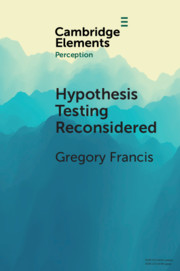Element contents
Hypothesis Testing Reconsidered
Published online by Cambridge University Press: 29 May 2019
Summary
- Type
- Element
- Information
- Series: Elements in PerceptionOnline ISBN: 9781108582995Publisher: Cambridge University PressPrint publication: 23 May 2019
References
- 13
- Cited by

